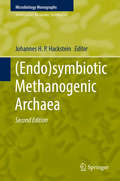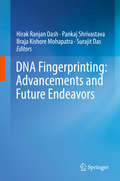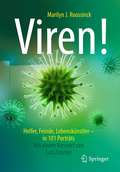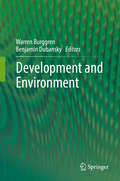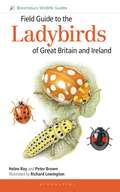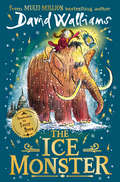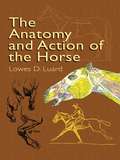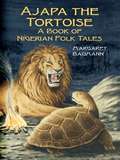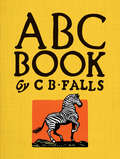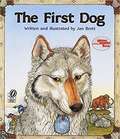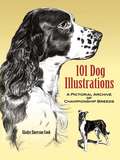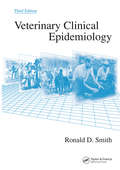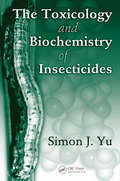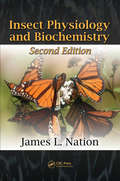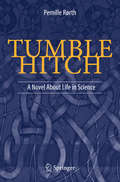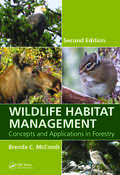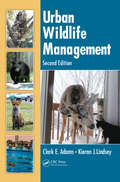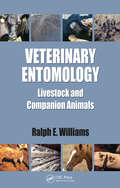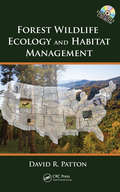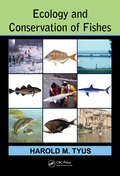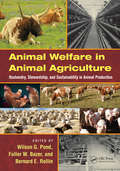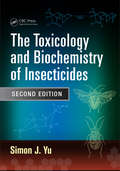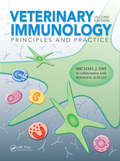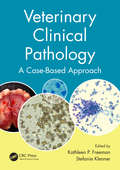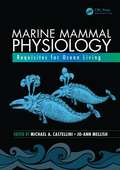- Table View
- List View
(Endo)symbiotic Methanogenic Archaea
by Johannes H. HacksteinThis updated monograph deals with methanogenic endosymbionts of anaerobic protists, in particular ciliates and termite flagellates, and with methanogens in the gastrointestinal tracts of vertebrates and arthropods. Further chapters discuss the genomic consequences of living together in symbiotic associations, the role of methanogens in syntrophic degradation, and the function and evolution of hydrogenosomes, hydrogen-producing organelles of certain anaerobic protists. Methanogens are prokaryotic microorganisms that produce methane as an end-product of a complex biochemical pathway. They are strictly anaerobic archaea and occupy a wide variety of anoxic environments. Methanogens also thrive in the cytoplasm of anaerobic unicellular eukaryotes and in the gastrointestinal tracts of animals and humans. The symbiotic methanogens in the gastrointestinal tracts of ruminants and other “methanogenic” mammals contribute significantly to the global methane budget; especially the rumen hosts an impressive diversity of methanogens. This makes this updated volume an interesting read for scientists and students in Microbiology and Physiology.
DNA Fingerprinting: Advancements and Future Endeavors
by Hirak Ranjan Dash Pankaj Shrivastava Braja Kishore Mohapatra Surajit DasThis book describes the basics and various applications of DNA fingerprinting, including in actual case studies. The book is divided in four modules; Module 1: Basics of DNA Fingerprinting, Module 2: Applications of DNA Fingerprinting, Module 3: DNA Fingerprinting: Case Studies, and Module 4: Future of DNA Fingerprinting. Each module consists of 4 to 5 chapters, written by reputed researchers, academics and forensic scientists from around the globe. The respective chapters cover e.g. related fields, the tools and techniques used, various genotyping kits, real-world case studies, ancient DNA and wild life forensics, molecular diagnosis of human diseases, legal aspects, microbial forensics and the economics of the DNA fingerprinting technique. The book offers a practical guide for professionals, graduate and post-graduate students in the fields of Forensic Science, Medicine, Genetics, Anthropology, Microbiology, and Zoology. It also serves as a useful reference resource, summarizing major technological advances in the field of DNA fingerprinting, the problems faced in this field of science and possible new solutions to these problems. Presently, DNA fingerprinting is utilized in solving the majority of criminal cases; as such, the book is also helpful for investigating agencies, as it includes representative case studies.
Viren!
by Marilyn J. RoossinckEinblicke in einer verborgene WeltViren sind Grenzgänger des Lebens. Mikroskopisch klein, als Krankheitserreger gefürchtet, doch in ihrer Vielfalt und in ihrer Bedeutung für die biologischen Netzwerke auf der Erde und für die Evolution des Lebens erst ansatzweise verstanden - und immer wieder für Überraschungen gut. Viren sind Opportunisten, die oft geduldig auf ihre Chance warten - in Ruhestadien oder eingebettet in das Erbgut ihrer Wirte -, und Meister der Anpassung. Ihre Vermehrungsstrategien und Übertragungsmechanismen sind so vielfältig wie ihre Erscheinungsformen. Die meisten Viren sind "nur" Nucleinsäuren in einer Proteinhülle, aber sie kapern Pflanzen-, Tier- und Bakterienzellen, nisten sich dort langfristig ein oder übernehmen unmittelbar die genetische Kontrolle. Dieser Band eröffnet einen faszinierenden Blick auf das ganze Panorama dieser Lebenskünstler, die wir gewöhnlich als Feinde betrachten, die aber auch Helfer sein können. Nach einer Einführung in die Grundlagen der Virologie - was genau sind Viren, woraus bestehen sie, wie sehen ihre Lebenszyklen aus, welche Evolutionspfade haben sie beschritten? - liefern 101 Porträts detaillierte Einblicke in die besonderen Eigenschaften und Fähigkeiten einzelner Virustypen, vom Grippeerreger bis zum Bakteriophagen T4, vom Tabakmosaikvirus bis zu den gefürchteten Ebola-, Zika- und Dengue-Viren.
Development and Environment
by Benjamin Dubansky Warren BurggrenRather than a loosely connected list of facts/topics, this book addresses virtually every field that involves the use of developing animals in environmental science. In doing so, it will help define the scientific collective within these fields to both those readers who are "outside" of a particular field (students and professionals alike) and those who work within said field, where multiple iterations of the same job description exist. Both the content and choice of authors fully support this goal, as the editors and contributing authors represent contemporary thought and experimentation in their respective fields – ranging from developmental physiology through environmental toxicology to medicine. As such, this work will appeal to a broad audience, including any scientist or trainee interested in the nexus of environment, development and physiology.
Field Guide to the Ladybirds of Great Britain and Ireland (Field Guides)
by Helen Roy Peter Brown Richard Lewington"A ground-breaking identification guide ... the perfect marriage of artistic excellence, deep knowledge and, dare I say it, of scientists' genuine affection." BRETT WESTWOODThis brand new illustrated field guide covers all 47 species of ladybird occurring in the British Isles in a handy and easy-to-use format. Twenty-seven species are colourful and conspicuous and easily recognised as ladybirds; the remaining species are more challenging, but the clear illustrations and up-to-date text in this guide will help to break down the identification barriers. A useful introduction provides an overview of ladybird ecology, tips on studying and recording, and suggested sites for finding ladybirds. The main part of the book comprises detailed species texts, covering field characters, food, habitats, suggested survey methods, ranges, conservation statuses and distribution trends. An illustrated at-a-glance identification guide and helpful pointers for differentiating similar-looking species are also included. With 102 colour photographs and 47 distribution maps, combined with Richard Lewington's peerless artwork, this is the definitive guide to one of our most cherished and charismatic insect groups.
The Ice Monster
by David Walliams Tony RossFrom No. 1 bestselling children’s author, David Walliams comes his biggest and most epic adventure yet! Illustrated by the artistic genius Tony Ross. This is the story of a ten-year-old orphan and a 10,000-year-old mammoth… Read all about it! Read all about it! ICE MONSTER FOUND IN ARCTIC! When Elsie, an orphan on the streets of Victorian London, hears about the mysterious Ice Monster – a woolly mammoth found at the North Pole – she’s determined to discover more… A chance encounter brings Elsie face to face with the creature, and sparks the adventure of a lifetime – from London to the heart of the Arctic! Heroes come in all different shapes and sizes in David Walliams’ biggest and most epic adventure yet!
The Anatomy and Action of the Horse
by Lowes D. LuardThis easy-to-read text explains the horse as a machine designed for movement. Using different colors in his drawings, the author not only describes with clarity the horse's skeleton and the functions of various muscles, but also creates images that have the power to suggest movement and stress. More than 75 illustrations include accurate diagrams and color illustrations fo the horse's anatomy, as well as meticulously rendered sketches of the entire animal.Of value to students and teachers of art, this book will also appeal to horse lovers who want a deeper understanding -- without having to examine the anatomical complexities of the subject -- of why this animal is capable of moving with such grace and speed.
Ajapa the Tortoise: A Book of Nigerian Folk Tales
by Margaret BaumannLong before people could turn to books for instruction and amusement, they relied upon storytellers for answers to their questions about life. Africa boasts a particularly rich oral tradition, in which the griot -- village historian -- preserved and passed along cultural beliefs and experiences from one generation to the next. This collection of 30 timeless fables comes from the storytellers of Nigeria, whose memorable narratives tell of promises kept and broken, virtue rewarded, and treachery punished.Ajapa the Tortoise -- a trickster, or animal with human qualities -- makes frequent appearances among the colorful cast of talking animals. In "Tortoise Goes Wooing," he learns a valuable lesson in friendship and sharing. Ajapa's further adventures describe how, among other things, he became a chief, acquired all of the world's wisdom, saved the king, tricked the lion, and came to be bald. Recounted in simple but evocative language, these ancient tales continue to enchant readers and listeners of all ages.
ABC Book
by C. B. FallsThis classic primer ranges from the familiar Antelope, Bear, and Cat to more unusual creatures ― the graceful Ibis, the aquatic Newt, the legendary Unicorn, and the powerful Xiphius, better known as the swordfish. Originally published in the 1920s, this volume is graced with striking poster art images of every animal. Each letter is represented by a full-page color woodcut illustration. In addition to its value to young learners, the ABC Book will appeal to collectors, bibliophiles, and others who appreciate beautiful books.
the first dog
by Jan BrettKip the Cave Boy offers to share all his woolly rhino ribs if Paleowolf will use his keen nose, fine ears, and sharp eyes to keep Kip from being eaten up. When Paleowolf agrees with a bark and a wag of his tail, Kip names his new friend Dog.
101 Dog Illustrations: A Pictorial Archive of Championship Breeds
by Gladys Emerson CookA blue-ribbon collection of 116 breeds recognized by the American Kennel Club, these dramatically detailed lithographs include sporting and non-sporting dogs, hounds, working dogs, terriers, and toys. A comprehensive reference for graphic artists and dog lovers, this compilation includes brief captions and concise, information-packed descriptions of each breed.
Veterinary Clinical Epidemiology
by Ronald D. SmithWhile veterinary medicine has always valued the concepts and methods of epidemiology, they are virtually inseparable in today's clinical practice. With access to an ever-expanding number of journals, as well as countless Internet sources, more and more veterinarians are practicing evidence-based medicine. This is defined as the process of sy
The Toxicology and Biochemistry of Insecticides
by Simon J. YuThe first book in two decades to address this multi-faceted field, The Toxicology and Biochemistry of Insecticides provides the most up-to-date information on insecticide classification, formulation, mode of action, resistance, metabolism, environmental fate, and regulatory legislation. The book draws on the author's groundbreaking research
Insect Physiology and Biochemistry
by James L. NationExpanded and updated, this second edition of a bestselling book challenges conventional entomological wisdom with the latest research and analytical interpretations. Encouraging independent evaluation of the data and allowing for the extrapolation of major concepts across species, this indispensable text establishes a thorough understanding of the
Tumble Hitch: A Novel About Life in Science
by Pernille RørthJessie Aitkin, the long-time Editor-in-Chief of a leading life sciences journal, receives a fantastic job offer. A young animal rights activist requests an interview with her husband, Peter Dahl, a research scientist at a prestigious institute. An unexpected revelation sets in motion a series of events that shifts the course of their careers and their relationship. In this novel, another page turner by the author of Raw Data: A Novel on Life in Science (Springer 2016), enthusiasm for basic research and for how science is – and could be – communicated combine in a thoughtful reflection on the impact of ambition on personal relationships. In a non-technical appendix, the author discusses the use of narrative in scientific papers and considers alternative modes of science publishing, one of which is featured in the novel. Storytelling in science has the potential to enhance communication, but may also have unintended consequences. This novel and the appendix explore these timely and important issues for the scientific community.
Wildlife Habitat Management: Concepts and Applications in Forestry, Second Edition
by Brenda C. McCombShortlisted for the 2018 TWS Wildlife Publication Awards in the authored book categoryIn recent years, conflicts between ecological conservation and economic growth forced a reassessment of the motivations and goals of wildlife and forestry management. Focus shifted from game and commodity management to biodiversity conservation and ecological fore
Urban Wildlife Management
by Clark E. Adams Kieran J. LindseyWhen the first edition of Urban Wildlife Management was published two years ago, it provided conservationists, ecologists, and wildlife professionals with a welcome shift in the way that interactions between humans and wildlife were viewed and managed. Instead of focusing on ways to evict or eradicate wildlife encroached on by urban development, th
Veterinary Entomology: Livestock and Companion Animals
by Ralph E. WilliamsLivestock production systems and some husbandry practices are prone to producing veterinary important entomological concerns. In addition, various arthropod-borne diseasessuch as West Nile and some types of encephalitiscan affect both humans and animals. To circumvent these problems successfully, a solid understanding of veterinary entomology shoul
Forest Wildlife Ecology and Habitat Management
by David R. PattonAcross the continental United States, one can identify 20 distinct forest cover types. Most of these are to be found on federal lands managed by the U.S. Forest Service and Bureau of Land Management. Those responsible for the management of trees that form the 20 different cover types and the diversity of forest wildlife that reside in them must hav
Ecology and Conservation of Fishes
by Harold M. TyusWritten as a stand-alone textbook for students and a useful reference for professionals in government and private agencies, academic institutions, and consultants, Ecology and Conservation of Fishes provides broad, comprehensive, and systematic coverage of all aquatic systems from the mountains to the oceans. The book begins with overview discussio
Animal Welfare in Animal Agriculture: Husbandry, Stewardship, and Sustainability in Animal Production
by Wilson G. Pond Fuller W. Bazer Bernard E. RollinWhat constitutes animal welfare? With animals being used for companionship, service, research, food, fiber, and by-products, animal welfare is a topic of great interest and importance to society. As the world's population continues to increase, a major challenge for society is the maintenance of a strong and viable food system, which is linked to t
The Toxicology and Biochemistry of Insecticides
by Simon J. YuDespite their potentially adverse effects on nontarget species and the environment, insecticides remain a necessity in crop protection as well as in the reduction of insect-borne diseases. The Toxicology and Biochemistry of Insecticides provides essential insecticide knowledge required for the effective management of insect pests. Continuing as the
Veterinary Immunology: Principles and Practice, Second Edition
by Michael J. Day Ronald D. SchultzVeterinary Immunology: Principles and Practice has become the adopted text in numerous veterinary schools throughout the world. Widely updated with advances in knowledge since 2011, this second edition reflects the rapid development in the field. The new edition presents expanded information on commonly used diagnostic test procedures and discusses
Veterinary Clinical Pathology: A Case-Based Approach
by Kathleen P. Freeman Stefanie KlennerVeterinary Clinical Pathology: A Case-Based Approach presents 200 cases with questions for those interested in improving their skills in veterinary clinical pathology. It emphasises an understanding of basic pathophysiologic mechanisms of disease, differential diagnoses and recognition of patterns associated with various diseases or conditions. Top
Marine Mammal Physiology: Requisites for Ocean Living (Crc Marine Biology Ser.)
by Michael A. Castellini Jo-Ann MellishSuppose you were designing a marine mammal. What would you need to think about to allow it to live in the ocean? How would you keep it warm? What would you design to allow it to dive for very long periods to extreme depths? Where would it find water to drink? How would you minimize the cost of swimming, and how would it find its prey in the deep an
